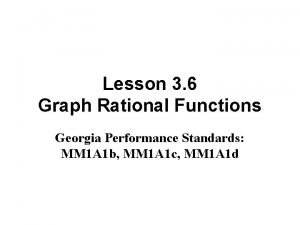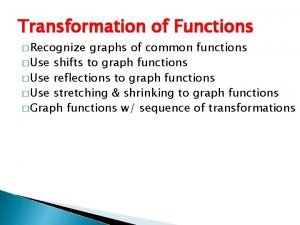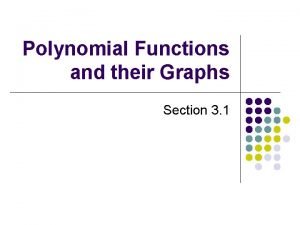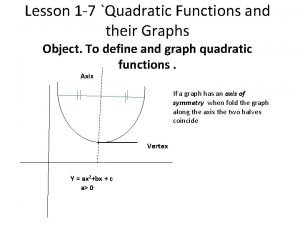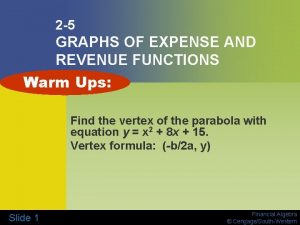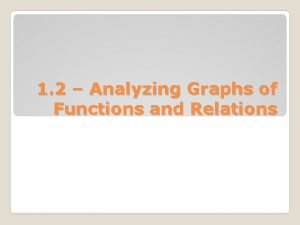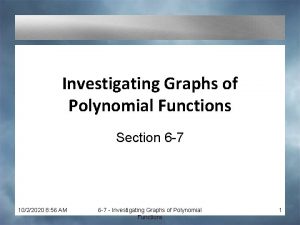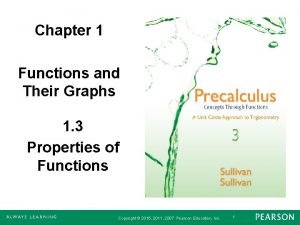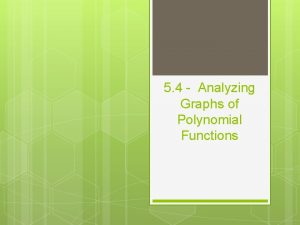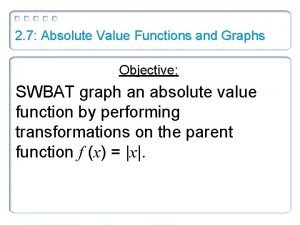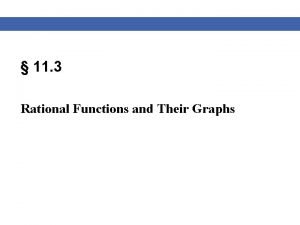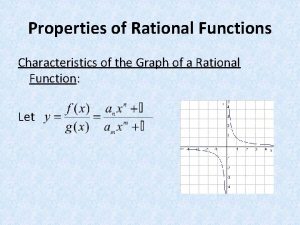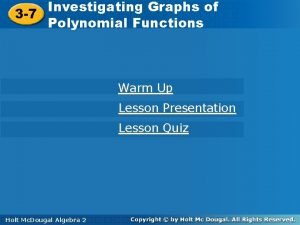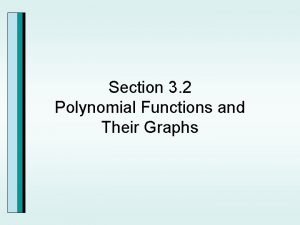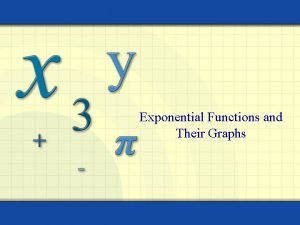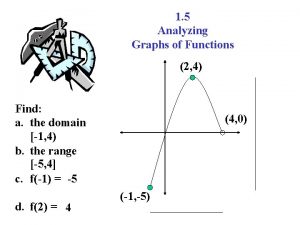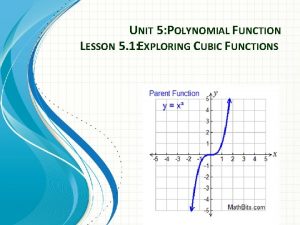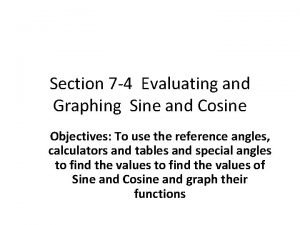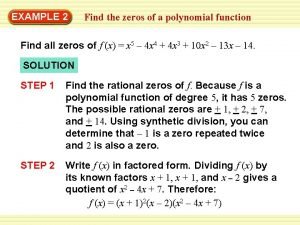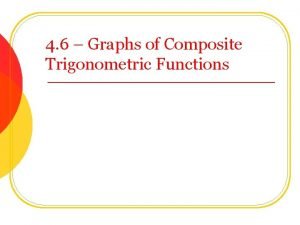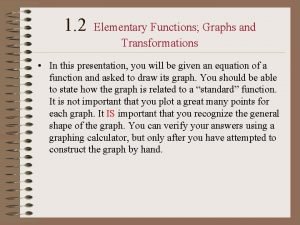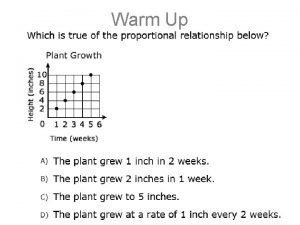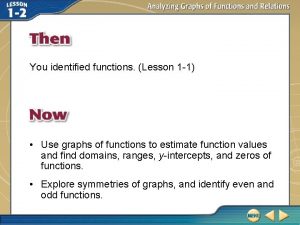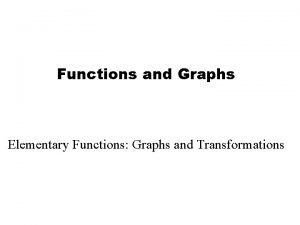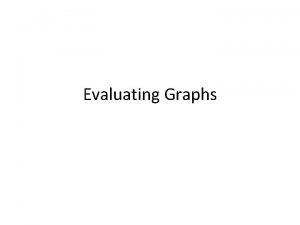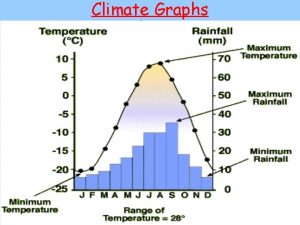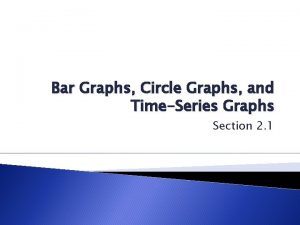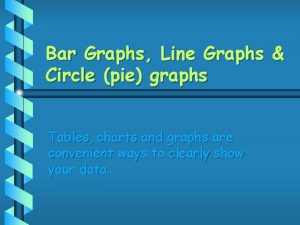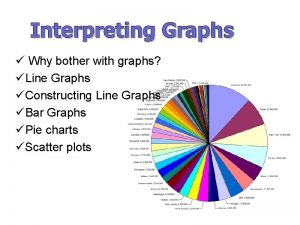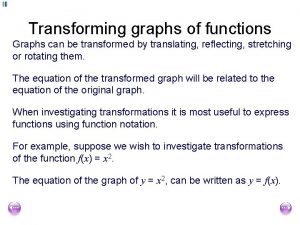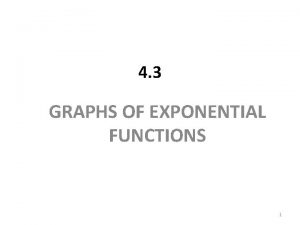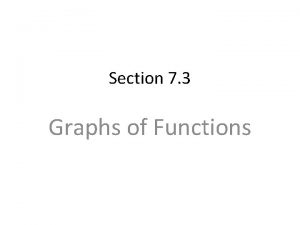You identified functions Lesson 1 1 Use graphs





















































- Slides: 53

You identified functions. (Lesson 1 -1) • Use graphs of functions to estimate function values and find domains, ranges, y-intercepts, and zeros of functions. • Explore symmetries of graphs, and identify even and odd functions.

• zeros • roots • line symmetry • point symmetry • even function • odd function

Estimate Function Values A. ADVERTISING The function f (x) = – 5 x 2 + 50 x approximates the profit at a toy company, where x represents marketing costs and f (x) represents profit. Both costs and profits are measured in tens of thousands of dollars. Use the graph to estimate the profit when marketing costs are $30, 000. Confirm your estimate algebraically.

Estimate Function Values $30, 000 is three ten thousands. The function value at x = 3 appears to be about 100 ten thousands, so the total profit was about $1, 000. To confirm this estimate algebraically, find f(3) = -5(3)2 + 50(3) = 105, or about $1, 050, 000. The graphical estimate of about $1, 000 is reasonable. Answer:

Estimate Function Values $30, 000 is three ten thousands. The function value at x = 3 appears to be about 100 ten thousands, so the total profit was about $1, 000. To confirm this estimate algebraically, find f(3) = -5(3)2 + 50(3) = 105, or about $1, 050, 000. The graphical estimate of about $1, 000 is reasonable. Answer: $1, 050, 000

Estimate Function Values B. ADVERTISING The function f (x) = – 5 x 2 + 50 x approximates the profit at a toy company, where x represents marketing costs and f (x) represents profit. Both costs and profits are measured in tens of thousands of dollars. Use the graph to estimate marketing costs when the profit is $1, 250, 000. Confirm your estimate algebraically.

Estimate Function Values $1, 250, 000 is 125 ten thousands. The value of the function appears to reach 125 ten thousands for an x-value of about 5. This represents an estimate of 5 ● $10, 000 or $50, 000. To confirm algebraically, find f(5) = -5(5)2 + 50(5) = 125, or about $1, 250, 000. The graphical estimate that marketing costs are $50, 000 when the profit is $1, 250, 000 is reasonable. Answer:

Estimate Function Values $1, 250, 000 is 125 ten thousands. The value of the function appears to reach 125 ten thousands for an x-value of about 5. This represents an estimate of 5 ● $10, 000 or $50, 000. To confirm algebraically, find f(5) = -5(5)2 + 50(5) = 125, or about $1, 250, 000. The graphical estimate that marketing costs are $50, 000 when the profit is $1, 250, 000 is reasonable. Answer: $50, 000

PROFIT A-Z Toy Boat Company found the average price of its boats over a six month period. The average price for each boat can be represented by the polynomial function p (x) = – 0. 325 x 3 + 1. 5 x 2 + 22, where x is the month, and 0 < x ≤ 6. Use the graph to estimate the average price of a boat in the fourth month. Confirm you estimate algebraically. A. $25 B. $23 C. $22 D. $20

PROFIT A-Z Toy Boat Company found the average price of its boats over a six month period. The average price for each boat can be represented by the polynomial function p (x) = – 0. 325 x 3 + 1. 5 x 2 + 22, where x is the month, and 0 < x ≤ 6. Use the graph to estimate the average price of a boat in the fourth month. Confirm you estimate algebraically. A. $25 B. $23 C. $22 D. $20

Find Domain and Range Use the graph of f to find the domain and range of the function.

Find Domain and Range Domain • The dot at (3, -3) indicates that the domain of f ends at 3 and includes 3. • The arrow on the left side indicates that the graph will continue without bound. The domain of f is domain is . In set-builder notation, the. Range The graph does not extend above y = 2, but f (x) decreases without bound for smaller and smaller values of x. So the range of f is.

Find Domain and Range Answer:

Find Domain and Range Answer: D: R:

Use the graph of f to find the domain and range of the function. A. Domain: Range: B. Domain: Range: C. Domain: Range: D. Domain: Range:

Use the graph of f to find the domain and range of the function. A. Domain: Range: B. Domain: Range: C. Domain: Range: D. Domain: Range:

Find y-Intercepts A. Use the graph of the function f (x) = x 2 – 4 x + 4 to approximate its y-intercept. Then find the y-intercept algebraically.

Find y-Intercepts Estimate Graphically It appears that f (x) intersects the y-axis at approximately (0, 4), so the y-intercept is about 4. Solve Algebraically Find f (0) = (0)2 – 4(0) + 4 = 4. The y-intercept is 4. Answer:

Find y-Intercepts Estimate Graphically It appears that f (x) intersects the y-axis at approximately (0, 4), so the y-intercept is about 4. Solve Algebraically Find f (0) = (0)2 – 4(0) + 4 = 4. The y-intercept is 4. Answer: 4

Find y-Intercepts B. Use the graph of the function g (x) =│x + 2│– 3 to approximate its y-intercept. Then find the y-intercept algebraically.

Find y-Intercepts Estimate Graphically g (x) intersects the y-axis at approximately (0, -1), so the y-intercept is about -1. Solve Algebraically Find g (0) = |0 + 2| – 3 or – 1 The y-intercept is – 1. Answer:

Find y-Intercepts Estimate Graphically g (x) intersects the y-axis at approximately (0, -1), so the y-intercept is about -1. Solve Algebraically Find g (0) = |0 + 2| – 3 or – 1 The y-intercept is – 1. Answer: -1

Use the graph of the function to approximate its y-intercept. Then find the y-intercept algebraically. A. – 1; f (0) = – 1 B. 0; f (0) = 0 C. 1; f (0) = 1 D. 2; f (0) = 2

Use the graph of the function to approximate its y-intercept. Then find the y-intercept algebraically. A. – 1; f (0) = – 1 B. 0; f (0) = 0 C. 1; f (0) = 1 D. 2; f (0) = 2

Find Zeros Use the graph of f (x) = x 3 – x to approximate its zero(s). Then find its zero(s) algebraically.

Find Zeros Estimate Graphically The x-intercepts appear to be at about -1, 0, and 1. Solve Algebraically x 3 – x= 0 Let f (x) = 0. x(x 2 – 1) = 0 Factor. x(x – 1)(x + 1) = 0 Factor. x = 0 or x – 1 = 0 or x + 1 = 0 Zero Product Property x=0 x =1 x = -1 The zeros of f are 0, 1, and -1. Answer: Solve for x.

Find Zeros Estimate Graphically The x-intercepts appear to be at about -1, 0, and 1. Solve Algebraically x 3 – x= 0 Let f (x) = 0. x(x 2 – 1) = 0 Factor. x(x – 1)(x + 1) = 0 Factor. x = 0 or x – 1 = 0 or x + 1 = 0 Zero Product Property x=0 x =1 x = -1 The zeros of f are 0, 1, and -1. Answer: -1, 0, 1 Solve for x.

Use the graph of to approximate its zero(s). Then find its zero(s) algebraically. A. – 2. 5 B. – 1 C. 5 D. 9

Use the graph of to approximate its zero(s). Then find its zero(s) algebraically. A. – 2. 5 B. – 1 C. 5 D. 9


Test for Symmetry A. Use the graph of the equation y = x 2 + 2 to test for symmetry with respect to the x-axis, the y-axis, and the origin. Support the answer numerically. Then confirm algebraically.

Test for Symmetry Analyze Graphically The graph appears to be symmetric with respect to the y-axis because for every point (x, y) on the graph, there is a point (-x, y). Support Numerically A table of values supports this conjecture.

Test for Symmetry Confirm Algebraically Because x 2 + 2 is equivalent to (-x)2 + 2, the graph is symmetric with respect to the y-axis. Answer:

Test for Symmetry Confirm Algebraically Because x 2 + 2 is equivalent to (-x)2 + 2, the graph is symmetric with respect to the y-axis. Answer: symmetric with respect to the y-axis

Test for Symmetry B. Use the graph of the equation xy = – 6 to test for symmetry with respect to the x-axis, the y-axis, and the origin. Support the answer numerically. Then confirm algebraically.

Test for Symmetry Analyze Graphically The graph appears to be symmetric with respect to the origin because for every point (x, y) on the graph, there is a point (-x, -y). Support Numerically A table of values supports this conjecture.

Test for Symmetry Confirm Algebraically Because (-x)( -y) = -6 is equivalent to (x)(y) = -6, the graph is symmetric with respect to the origin. Answer:

Test for Symmetry Confirm Algebraically Because (-x)( -y) = -6 is equivalent to (x)(y) = -6, the graph is symmetric with respect to the origin. Answer: symmetric with respect to the origin

Use the graph of the equation y = –x 3 to test for symmetry with respect to the x-axis, the y -axis, and the origin. Support the answer numerically. Then confirm algebraically. A. symmetric with respect to the x-axis B. symmetric with respect to the y-axis C. symmetric with respect to the origin D. not symmetric with respect to the x-axis, y-axis, or the origin

Use the graph of the equation y = –x 3 to test for symmetry with respect to the x-axis, the y -axis, and the origin. Support the answer numerically. Then confirm algebraically. A. symmetric with respect to the x-axis B. symmetric with respect to the y-axis C. symmetric with respect to the origin D. not symmetric with respect to the x-axis, y-axis, or the origin


Identify Even and Odd Functions A. Graph the function f (x) = x 2 – 4 x + 4 using a graphing calculator. Analyze the graph to determine whether the function is even, odd, or neither. Confirm algebraically. If even or odd, describe the symmetry of the graph of the function.

Identify Even and Odd Functions It appears that the graph of the function is neither symmetric with respect to the y-axis nor to the origin. Test this conjecture algebraically. f (-x) = (-x) 2 – 4(-x) + 4 = x 2 + 4 x + 4 Substitute -x for x. Simplify. Since –f (x) = -x 2 + 4 x - 4, the function is neither even nor odd because f (-x) ≠ f (x) or –f (x). Answer:

Identify Even and Odd Functions It appears that the graph of the function is neither symmetric with respect to the y-axis nor to the origin. Test this conjecture algebraically. f (-x) = (-x) 2 – 4(-x) + 4 = x 2 + 4 x + 4 Substitute -x for x. Simplify. Since –f (x) = -x 2 + 4 x - 4, the function is neither even nor odd because f (-x) ≠ f (x) or –f (x). Answer: neither

Identify Even and Odd Functions B. Graph the function f (x) = x 2 – 4 using a graphing calculator. Analyze the graph to determine whether the function is even, odd, or neither. Confirm algebraically. If even or odd, describe the symmetry of the graph of the function.

Identify Even and Odd Functions From the graph, it appears that the function is symmetric with respect to the y-axis. Test this conjecture algebraically. f (-x) = (-x)2 – 4 Substitute -x for x. = x 2 - 4 Simplify. = f (x) Original function f (x) = x 2 – 4 The function is even because f (-x) = f (x). Answer:

Identify Even and Odd Functions From the graph, it appears that the function is symmetric with respect to the y-axis. Test this conjecture algebraically. f (-x) = (-x)2 – 4 Substitute -x for x. = x 2 - 4 Simplify. = f (x) Original function f (x) = x 2 – 4 The function is even because f (-x) = f (x). Answer: even; symmetric with respect to the y-axis

Identify Even and Odd Functions C. Graph the function f (x) = x 3 – 3 x 2 – x + 3 using a graphing calculator. Analyze the graph to determine whether the function is even, odd, or neither. Confirm algebraically. If even or odd, describe the symmetry of the graph of the function.

Identify Even and Odd Functions From the graph, it appears that the function is neither symmetric with respect to the y-axis nor to the origin. Test this conjecture algebraically. f (–x) = (–x) 3 – 3(–x)2 – (–x) + 3 Substitute –x for x. = –x 3 – 3 x 2 + x + 3 Simplify. Because –f (x) = –x 3 + 3 x 2 + x – 3, the function is neither even nor odd because f (–x) ≠ f (x) or –f (x). Answer:

Identify Even and Odd Functions From the graph, it appears that the function is neither symmetric with respect to the y-axis nor to the origin. Test this conjecture algebraically. f (–x) = (–x) 3 – 3(–x)2 – (–x) + 3 Substitute –x for x. = –x 3 – 3 x 2 + x + 3 Simplify. Because –f (x) = –x 3 + 3 x 2 + x – 3, the function is neither even nor odd because f (–x) ≠ f (x) or –f (x). Answer: neither

Graph the function f (x) = x 4 – 8 using a graphing calculator. Analyze the graph to determine whether the graph is even, odd, or neither. Confirm algebraically. If even or odd, describe the symmetry of the graph of the function. A. odd; symmetric with respect to the origin B. even; symmetric with respect to the y-axis C. neither even nor odd

Graph the function f (x) = x 4 – 8 using a graphing calculator. Analyze the graph to determine whether the graph is even, odd, or neither. Confirm algebraically. If even or odd, describe the symmetry of the graph of the function. A. odd; symmetric with respect to the origin B. even; symmetric with respect to the y-axis C. neither even nor odd

 Degree and leading coefficient
Degree and leading coefficient Horizontal asymptote rule
Horizontal asymptote rule Lesson 4-2 practice a inverses of relations and functions
Lesson 4-2 practice a inverses of relations and functions 1-2 analyzing graphs of functions and relations answers
1-2 analyzing graphs of functions and relations answers Lesson 3: rational functions and their graphs
Lesson 3: rational functions and their graphs Yesterday
Yesterday Testability tips in state graphs
Testability tips in state graphs Graphs that compare distance and time are called
Graphs that compare distance and time are called Graphs that enlighten and graphs that deceive
Graphs that enlighten and graphs that deceive Piecewise functions in real life situations with answers
Piecewise functions in real life situations with answers Graphs of trig functions
Graphs of trig functions Common functions graphs
Common functions graphs Hyperbolic tangent
Hyperbolic tangent Types of polynomials based on degree
Types of polynomials based on degree Quadratic functions and their graphs
Quadratic functions and their graphs Practice a investigating graphs of polynomial functions
Practice a investigating graphs of polynomial functions Investigating graphs of functions for their properties
Investigating graphs of functions for their properties Sketching graphs of quadratic functions
Sketching graphs of quadratic functions Removable and non removable discontinuities
Removable and non removable discontinuities Algebra graphs and functions
Algebra graphs and functions 2-5 graphs of expense and revenue functions answer key
2-5 graphs of expense and revenue functions answer key 1-2 analyzing graphs of functions and relations
1-2 analyzing graphs of functions and relations Interpreting graphs of functions algebra 1
Interpreting graphs of functions algebra 1 6-7 investigating graphs of polynomial functions
6-7 investigating graphs of polynomial functions Chapter 1 functions and their graphs
Chapter 1 functions and their graphs Analyzing graphs of functions
Analyzing graphs of functions 5-4 analyzing graphs of polynomial functions
5-4 analyzing graphs of polynomial functions 2-7 absolute value functions and graphs
2-7 absolute value functions and graphs Rational functions and their graphs
Rational functions and their graphs Analyzing graphs of polynomial functions calculator
Analyzing graphs of polynomial functions calculator Common functions and their graphs
Common functions and their graphs Properties of rational functions
Properties of rational functions 6-7 investigating graphs of polynomial functions
6-7 investigating graphs of polynomial functions Chapter 2 functions and graphs
Chapter 2 functions and graphs Polynomial functions and their graphs
Polynomial functions and their graphs Exponential functions and their graphs
Exponential functions and their graphs Chapter 2 functions and their graphs answers
Chapter 2 functions and their graphs answers Chapter 1 graphs functions and models answers
Chapter 1 graphs functions and models answers Analyzing graphs of functions
Analyzing graphs of functions Unit 5: polynomial functions
Unit 5: polynomial functions Trigonometric graph equation
Trigonometric graph equation Rational functions and their graphs
Rational functions and their graphs Zero polynomial
Zero polynomial Chapter 2 functions and graphs
Chapter 2 functions and graphs Graphs of composite trigonometric functions
Graphs of composite trigonometric functions Elementary functions graphs
Elementary functions graphs Alap
Alap Lesson 9 awkward who chose the number 360
Lesson 9 awkward who chose the number 360 Interpreting graphs of proportional relationships
Interpreting graphs of proportional relationships Under identified model
Under identified model Match the description with the example whmis
Match the description with the example whmis Benjamin west contributed a great deal to american art
Benjamin west contributed a great deal to american art Intrinsic motivation
Intrinsic motivation Identified motivation
Identified motivation




